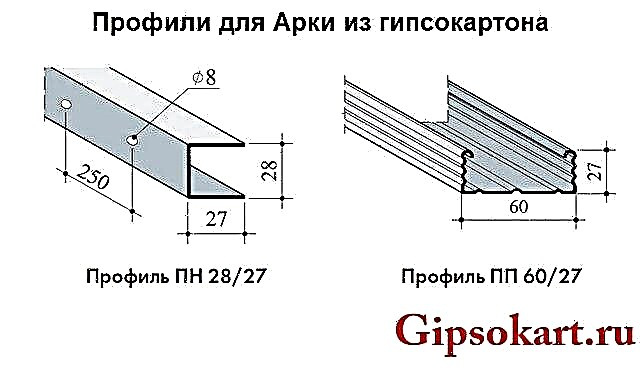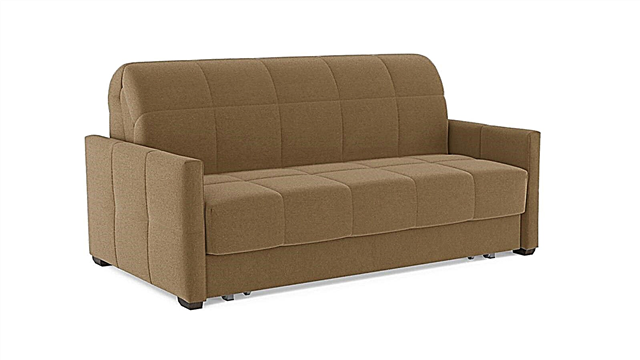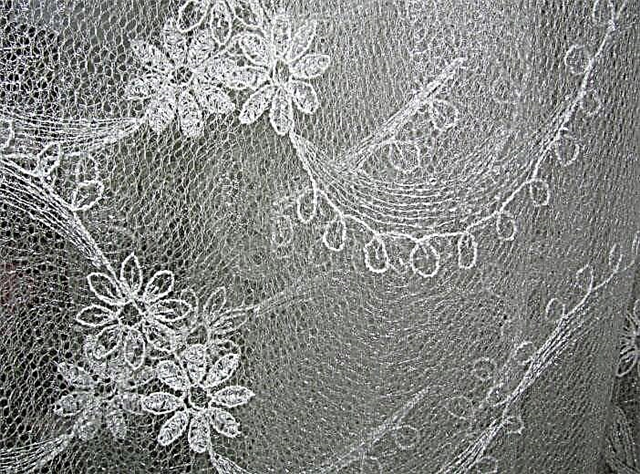Let's pay a little attention to the warm and comfortable room - the kitchen. A Provence style kitchen is the cradle of comfort and simplicity, combined with beauty and functionality. And the apron, of course, needs an appropriate one.
The kitchen in this style is decorated exclusively in bright colors. Furniture is made in various colors, such as beige, white, green or blue. Kitchen worktops are often finished with stone or its imitation.
Skalins and aprons for kitchens in the Provence style, as a rule, have a large number of bright ceramic dishes, wicker baskets, vases, which makes the interior most pleasant. If in the center of the dining area there is a wooden table of round or square shape, covered with a tablecloth, then as an accessory on the table or the image of the apron, a beautiful vase with wildflowers, for example, lavender, is used.
So what are the main features of an apron in the style of provence and how not to confuse it with another style?
- In the Provence style, only pastel colors are used.
- the background of such skinali is often wood, which can be whitened and decorated with floral ornaments,
- a huge number of all kinds of floral patterns and ornaments, bright accents,
History and Modernity
Provence style is named after the French city in which it appeared. This word itself is translated as "province". At the heart of this style is the beauty of the French province. In the interior, this style most accurately conveys the life of the hinterland with all the shortcomings to which designers give a kind of charm.

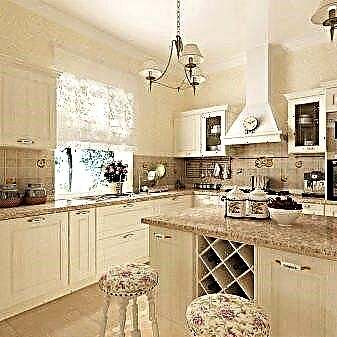
To date, the main features of this style are still preserved. The interior in the Provence style is dominated by pastel colors. For decoration, natural materials are used whenever possible. They can even be artificially aged.
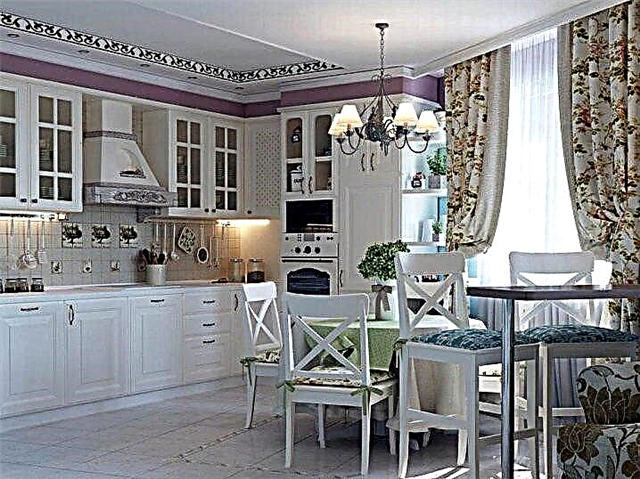
Colors
An ideal kitchen in this style should not be complemented by too bright colors. This will kill all the charm of the French province. The same goes for too dark colors - black, dark blue or saturated emerald.
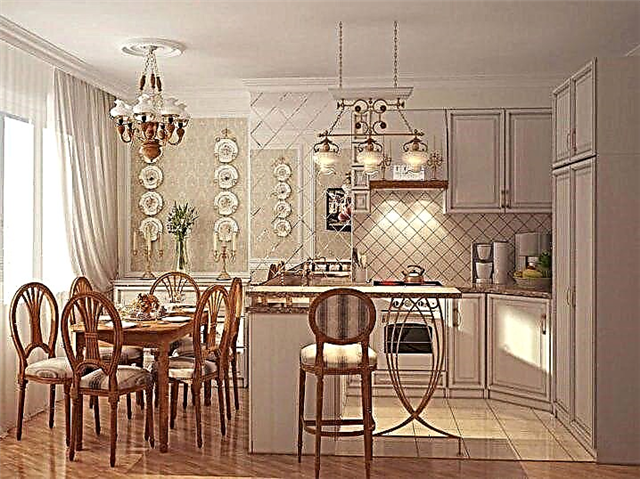
The colors in the Provence style should be dominated by light and pastel colors. First of all, it is milk, beige, coffee or ivory. Wood inserts can be made in light shades of brown. The notes of charm will add shades of blue, lavender or light green to this style. These light shades should prevail both at the base of the interior, and in small details.
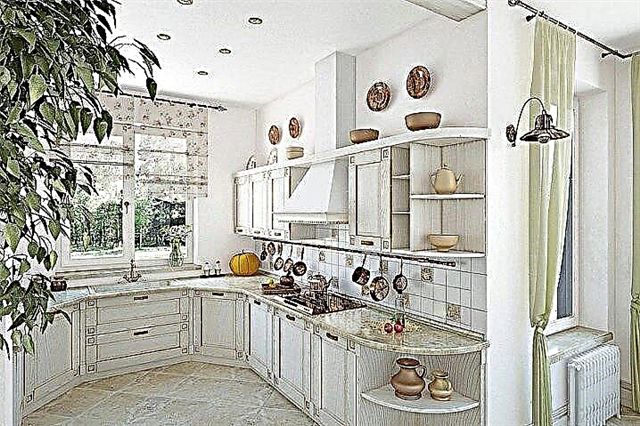
A Provencal kitchen apron in a kitchen is also usually subject to the main trends. It is he who is the central part of the interior. The gaze of everyone who first visits the kitchen falls on him. Therefore, this part should be not only practical, but also aesthetically attractive.
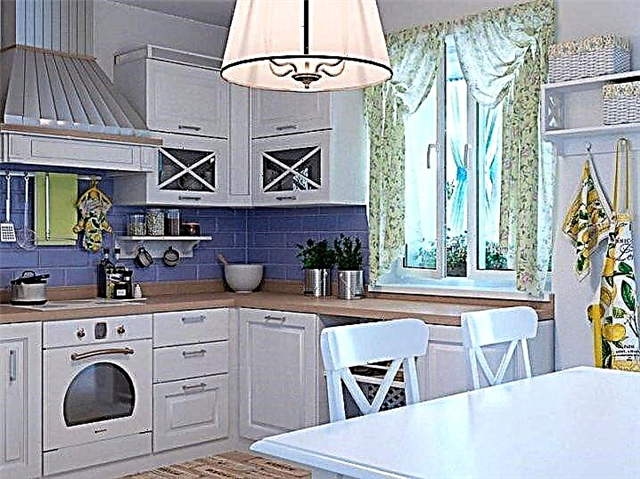
When decorating the kitchen, you can choose a plain apron or decorated with exquisite patterns in the "French" style. It can be decorated with abstractions or exquisite floral and floral prints.
We have already talked about what colors are best used in the interior in the Provence style. As for the patterns, in the Provencal style kitchen you can use images of lavender fields, exquisite light colors and other elements of everyday life in the French province.
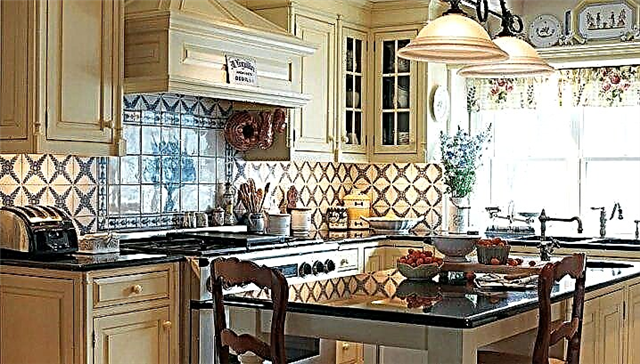
Materials
Kitchen aprons are made from different materials. The final cost of an apron for modern cuisine in the Provence style depends on which one was used. The most common options are plastic, glass, metal and tile. In the kitchen, made in an elegant Provencal style, all synthetic materials will be inappropriate. Therefore, in such an interior it is better to install aprons made of brickwork or ceramic tiles.
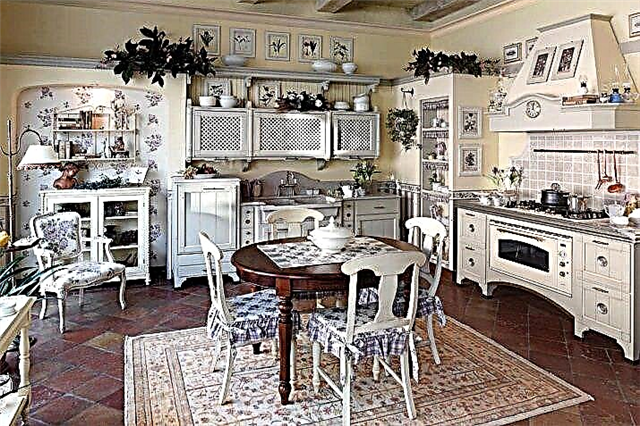
Ceramic tile
The easiest way to lay ceramic tiles is to create mosaic patterns. Today, pictures in the style of patchwork are popular. Such a canvas resembles a colorful blanket sewn from small scraps of fabric. In a kitchen made in the Provence style, such an apron will look very good. The squares that make up the canvas can be completely different: plain, patterned, or parts of the whole picture, torn from the general image.
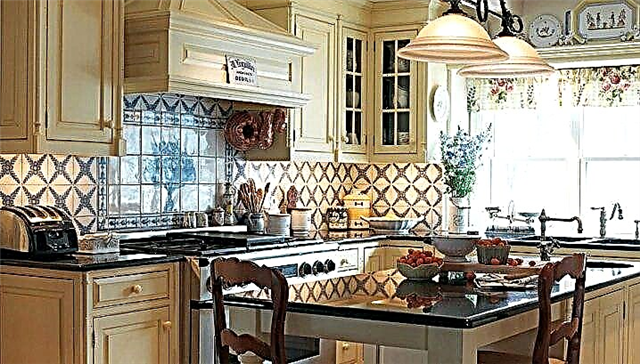
When creating such an apron, individual details are stacked randomly, and the creators have no goal to form some kind of overall picture.
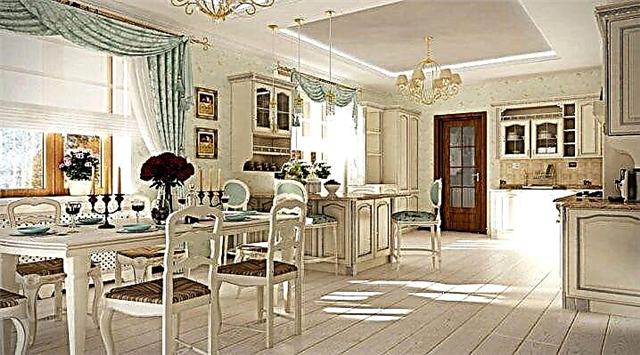
Made of aged tiles
The Provence style often uses all kinds of details in a vintage style. As an example, artificially aged ceramic tiles. Such a move is suitable for creating an apron in the so-called rustic style.
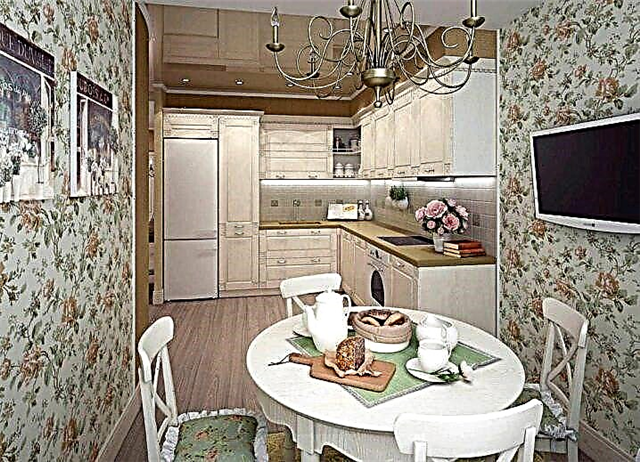
An added benefit is the wide seams between the individual tiles. They allow you to restore the necessary mood and convey the atmosphere of French provincial kitchens.
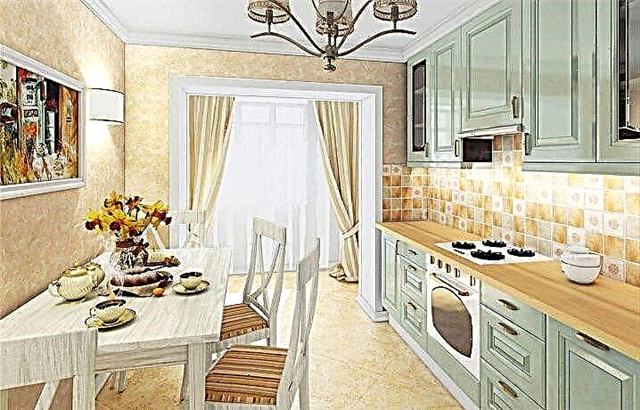
Made of natural stone
The Provence style uses a lot of natural materials, and stone is no exception. Kitchen aprons, trimmed with natural stone, are suitable even for a small room. Its obvious advantage is durability and high quality. An apron made of natural stone will retain its original appearance for a long time. He is not afraid of moisture or all kinds of mechanical damage.
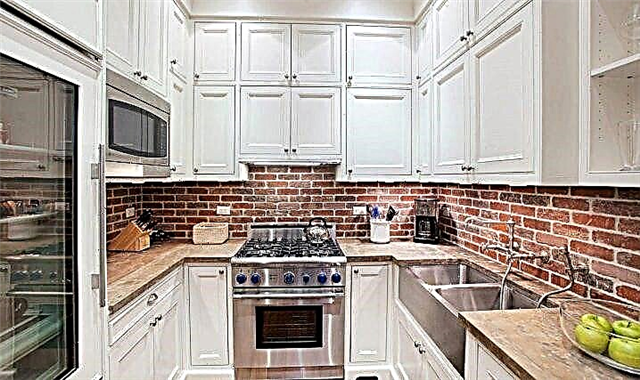
But natural stone is a rather expensive material. Therefore, not everyone can afford such an apron. Replace it with a good imitation of natural stone, made of simple ceramic tiles.
By the way, ceramic tiles can be stylized not only for masonry, but also for a brick wall. This is also true in the Provence style interior. Ceramic apron is also good because it is resistant to dirt. No spots will be visible against its background.

French-style kitchen aprons are a combination of pastel colors, natural materials and rough finishes. Such a detail embodies all the basic notes characteristic of this style, therefore, take its choice responsibly.
The choice of tiles for the kitchen
Correctly selected ceramics can successfully emphasize all the features of the Provence style and create the desired "Mediterranean" mood. Although the Provencal concept involves the use of natural materials, you should not give up tiles. In the kitchen, practicality and hygiene are important, and only tiles fully correspond to these characteristics.
Floor tiles
The tile for the floor in any room must meet two requirements - withstand mechanical stress and not slip. Traditionally, floor tiles have a greater thickness than wall tiles - at least 6 mm. The thicker you choose the tile, the more durable the coating will be. He will not be afraid of falling heavy objects, the installation of massive furniture and household appliances.
To comply with the Mediterranean concept, you should focus on textured versions of tiles that mimic natural materials. The Provencal kitchen will look good imitation wood, marble, stone, brick and even sand. It makes no sense to choose a multi-colored or printed design - it is better to leave the floor plain, in pastel colors.
In the kitchen room, oversized tiles are considered the most practical - due to the small number of seams, it is easier to care for.
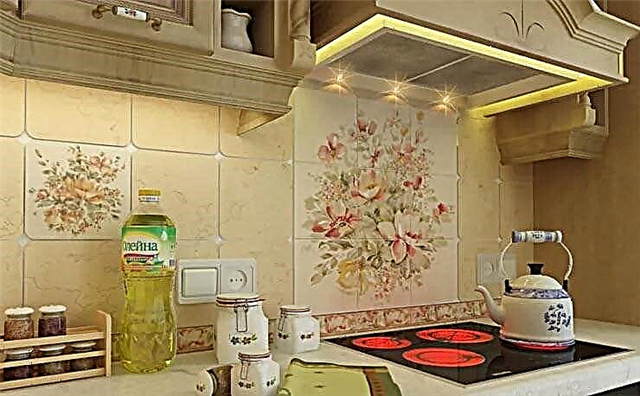
For a kitchen apron
In the design of the working area, you can experiment not only with colors, but also with the size of the tiles. If you want to create a decent Provencal atmosphere, it is better to dwell on fine tiles and mosaic coating. Patchwork-style decor is especially popular - such a lining will resemble a colorful blanket sewn from different fabric sections.
If you prefer practicality, choose seamless or oversized tiles. The best decor options are small flowers, bouquets, interweaving of leaves and patterns. An interesting solution is a tile with thematic photo printing. You can depict anything on it - from a fruit basket and steaming cups of coffee to pastoral village paintings.
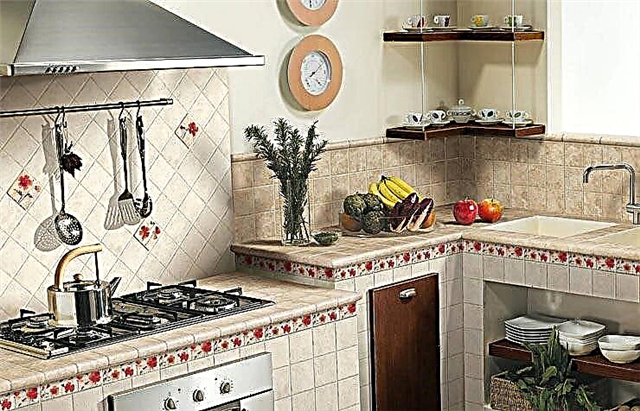
Wall Decor and Interior Design
In the Provencal style, smooth and glossy surfaces are absolutely inappropriate. When choosing a decor, attention is paid only to rough textured materials corresponding to the rustic theme.
The walls can be decorated with elements of brickwork, structured porcelain stoneware or natural stone. Rough wooden details reminiscent of proximity to nature, and even old boards, will do.
As a rule, natural finishing materials are expensive. Therefore, many owners prefer high-quality imitation based on artificial analogues.
Designers do not recommend wallpapering the walls of the "rustic" kitchen - it is better to paint them in the selected color palette. If the choice nevertheless fell on the wallpaper, it is better to choose textured canvas on a non-woven basis with floral motifs or ornament. Another suitable solution is structural paint or decorative plaster coated with water-based paint.
Color palette
Favorite Provencal interiors are shades of pastel colors in a wide palette. Colors should not be too bright and flashy - naturalness is welcome in everything, even in shades. The most successful color options will be:
- white - a classic color that blends perfectly with any other tone. But you shouldn’t make the kitchen completely white, otherwise you will create the effect of a “hospital” interior,
- olive - makes the kitchen cozy, harmonizes well with furniture in dark colors. Dark olive is suitable for large rooms, light olive for small rooms,
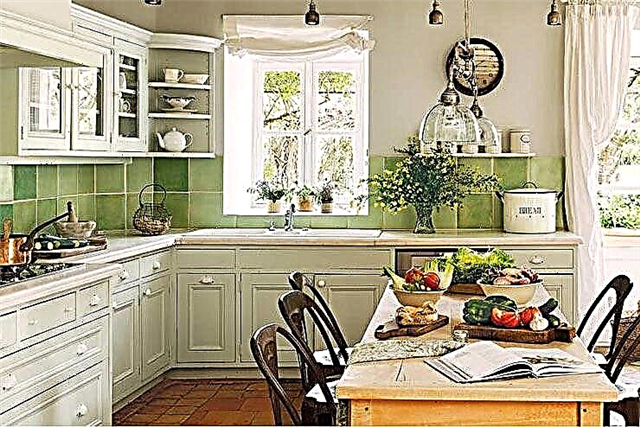
- pistachio - refreshes the kitchen furniture, makes the kitchen summer and airy, blends perfectly with light and dark wood,
- sand and brown - these colors look familiar, because they are appropriate in almost all styles, not only Provencal,
- blue - refreshes the interior, brings a touch of coolness, as it is associated with the sea. Blue and white are the perfect tandem,
- any variants of blue - "work" in the same way as blue, but have better combinatoriality. They are in harmony not only with white, but also with green, brown, blue.
Multi-colored
Provence is one of the few interior styles where a colorful motley tile will be appropriate. Such tiles can combine not only different tones, but also a variety of prints, stripes of different directions and interesting textures.
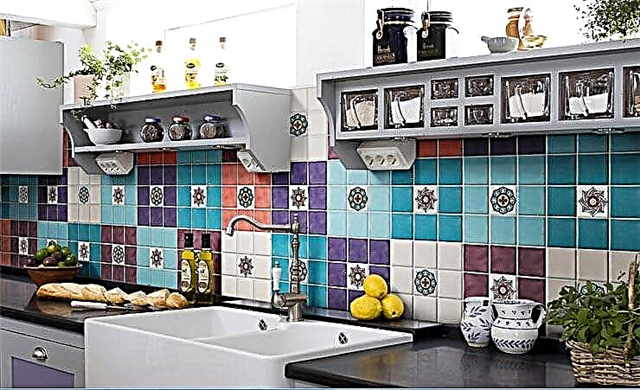
But even in Provencal cuisine with such a lining, it is important not to abuse it. If motley decoration is chosen for the walls, then the furniture, textiles and decor elements should be as muffled, monophonic as possible. It is best to make a multi-colored kitchen apron, and paint the rest of the walls in one tone.
With flowers
Floral prints are a classic of authentic Provencal style. Without this print, it is difficult to create a cozy rustic atmosphere and give the kitchen cheerfulness. Sunflower flowers look especially warm, but any floral print, especially a small one, will be appropriate.
Large inflorescences are allowed to be used only as separate elements of the working kitchen area. The same design is suitable for tiles with photo printing.
Terracotta
One of the design options for the Provencal style kitchen is the use of terracotta color. It is associated with natural ceramics and flower pots, so it fits perfectly into the "rustic" style.
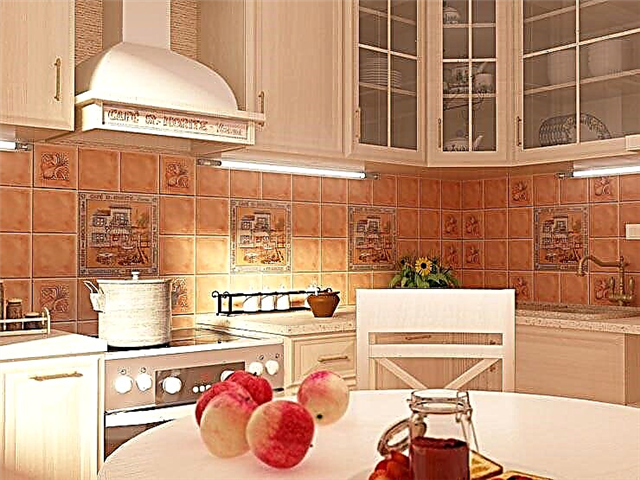
The palette of terracotta tiles starts from earthy beige to rich brick shades. As a rule, the surface of such tiles is textured, which creates the effect of wear and deterioration. Terracotta tiles are considered one of the most practical. It is absolutely not easily soiled, suitable for dusty areas and areas with heavy traffic, which include the kitchen.
White blue
Blue color is typical for the Provence style - it is used both for the decoration of facades and for wall cladding. If the interior contains tones of blue and its shades, then white-blue tiles will be a good decoration. White shades all colors well, but looks especially impressive to a company with rich azure.
Blue Provence style is suitable for kitchens, whose windows face south and give a large amount of light. A blue and white tile will bring an element of coolness into space and help balance lighting levels.
With pictures
Features of the Provencal style are closely related to the French province of the same name, the inhabitants of which were mainly villagers. Therefore, any drawings and pictures of rural life are associated with the Provence style - shepherds and shepherdesses, roosters and birds, bouquets and buds, baskets and flower pots, ears of cereals and sheaves of wheat.
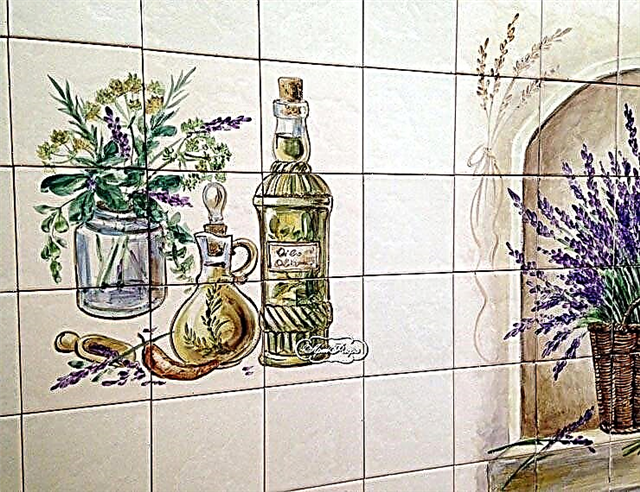
Lavender flowers are considered a classic print for Provencal tile, as well as the lilac shade characteristic of this plant. Such a tile will look good in a kitchen decorated with dried lavender bouquets or textiles in the same style.
The only requirement is that the drawings should not be bright and the colors juicy. The room should be designed in muted, discreet colors.
Hexagonal
Hexagonal tiles - the choice of large originals who are looking for new custom solutions in the decor. Many are attracted by the shape of ceramics, reminiscent of a honeycomb - it is this association that allows the use of hexagonal tiles in the Provence style. With it, you can smooth straight lines, give the cladding softness and originality.
Most often, hexagon tiles are used to finish the floor, but it is not forbidden to use it on the walls. So that the lining does not look boring, but plays with new colors, hexagons of different colors are combined on the same plane. But you should choose shades from one color palette - the only way they will look harmonious.
Beveled
Tile with chamfer, or beveled edges, looks like a brick. And thanks to the variety of colors in the Provencal cuisine, it can easily be stylized as brickwork. In this case, the “pull-out” cladding scheme is applied when the tile of the upper row overlaps half the length of the tile of the lower row.
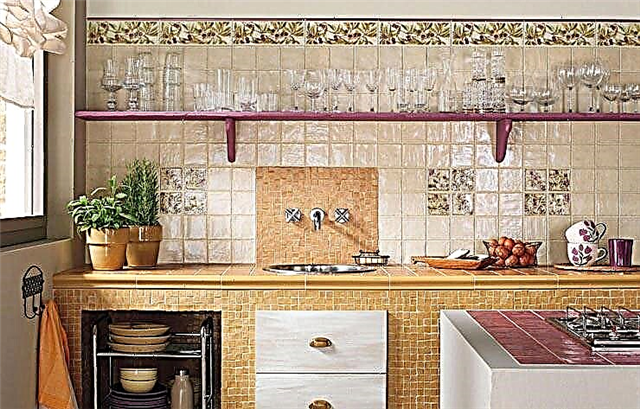
Various color combinations can be used, for example, one of the walls is decorated with coffee-milk-colored tiles, and the other wall is made in chocolate color. Facing masters are able to create whole pictures from a multicolor tile with a facet, laying it according to a certain pattern.
Under the brick
This version of tile in style echoes the previous one. Imitation of brickwork allows you to create the same texture effect that is typical for the Provence kitchen style.
An important advantage of brick tiles is excellent combinatoriality. She will create a harmonious tandem with wood, metal elements, plywood, concrete, natural stone, glass, paper wallpaper, painted walls.
Provence palette in the kitchen
Everyone has heard about pastel colors and roughly imagine how they look. The description usually comes down to “pale” and “tender”. Well, exotic names: dirty blue, pistachio, olive, cream, etc.
It is the “dirty color” that best describes the palette acceptable in the interior of a Provence style kitchen. The colors are white and gray. And only fairly diluted in this way shades should be used.
The kitchen is already loaded with objects and functions, and the Provence style still enhances everything. Even the precise use of saturated colors will upset the balance and ruin the atmosphere. Plus, they cannot be combined.I analyzed this topic in detail in the material about the combination of colors in the interior.
The more different shades and the more you want to use them on a larger area, the more white and gray fractions should be in these tones.
Do not fall in love with individual objects. You should not like them in isolation from the entire interior. Otherwise they will be too bright and greedy. No Provence Style Kitchen - The eye should not cling to anything. This is a serious difference from most modern areas, where the interior is built on the principle of background accent.
2 cool photos:
They are beautiful in this design and do not tolerate the addition of details, but this is a different style. In Provence, the kitchen is oversaturated with details - order through chaos. If you're a perfectionist and can't stand the mess, 1 of the styles below will work best for you. They are similar and sometimes it is impossible to pinpoint a line.
- Scandinavian-style kitchen - the colors are the same, more woody shades and white, a mixture of modern and vintage details, elements of minimalism and a loft.
- The kitchen is in the Neoclassical style - the furniture is similar, stricter, without extra accessories, modern appliances without imitating vintage objects, more practical and easier to maintain order.
- Classical kitchens - light colors, patina, luxury.
1. Furniture and household appliances
2 main differences of a kitchen set for Provence:
- Facades with milling from MDF or solid.
- Cabinets with transparent sashes (like a buffet).
These two features are enough to fit. Then you can follow the rules from articles about choosing a kitchen and designing a small kitchen, then the interior will also be practical.
- To the ceiling. The upper section can be made with glass sashes. It looks better than crates not to the top. And more practical than open shelves. If you still want to abandon the top, read what nuances lie in wait for the kitchen without upper cabinets.
- There are no flowers of a natural tree - it is characteristic of Scandinavian styles, but not French. Either enameled facades without any texture are used, or an array treated with impregnation and bleached (see photo below).
- Copper and brass instead of aluminum and chromium. This applies to stylized vintage equipment (oven, microwave, stove), handles (door and furniture), faucet. It is possible with scuffs.
- If the area allows you to lose storage space around the hood (starting from the kitchen with an area of 9 sq.m.), you can do a separate one. Otherwise, it’s built-in. The photo shows how to beat.
- Provence is the only style where a sofa or kitchen corner will fit organically.
2. Curtains and tablecloths
Although usually textiles are not a key element of the interior of the kitchen, for the Provence style, curtains and tablecloths form coziness and mood.
For modern styles, I advise you to restrict yourself to strict straight blackout curtains, but there are tons of options.
If the priorities are in favor of practicality, then maxi-format blinds are suitable (for the entire window opening). I don’t advise on individual leaves - they look wretched.
If there is a balcony, only curtains remain. Short curtains for provence in the kitchen are suitable. Drapery (when they look like assembled waves) and lambrequins (horizontal part with drapery at the top of the window) too. Sheer curtains and tulle are good.
Read a separate article about curtains in the kitchen and separately about curtains in the kitchen with a balcony - in both articles there are more than 120 photos, and textiles are important.
All this cannot be used in other styles. But in Provence, this provincial French country spirit is what we need.
Often they go for the maximum addition of textiles and use covers for chairs and curtains on the cabinet doors. It is important to remember that this is not functional.
3. Wallpaper
Consider refusing to overload textiles in favor of wallpaper - they do not collect dust. There is a separate article about wallpapers in the kitchen - questions which can be used, how to combine accents and background are already considered there.
For provence in the kitchen, wallpapers with a stretched pattern with floral or floral motifs are well suited. Create the right mood and resonate with the flowing lines of furniture.
But it is better to refrain from a small repeating pattern - it looks cheap in a bad sense. Wall mural also by -
too risky option.
4. Tile
Standard options for a kitchen apron in the Provence style are tile with a pattern (patchwork), white bricks (white boar), imitation of aged stone (travertine, sand shades).
Problem: Small square tiles are usually used. Consequently, there will be many seams. And although the tile itself is stable, grouting is its weak point. Solved by money and using epoxy. Or choose the right grout color.
For the floor, tiles with sandy colors and shades, imitation of abrasion - the Mediterranean version, is well suited both in design and practicality. She does not draw attention to herself, does not conflict in color and texture.
5. Lighting
I usually advise you to make a lot of hidden light, but in a Provence-style kitchen from hidden sources, we restrict ourselves to illuminating the apron.
This style looks good both in natural light and with its lack. Therefore, simply having any additional dimmed lighting will be sufficient. It’s easier here.
The color temperature of the lamps should not be higher than 4000K. Otherwise, the light will be too cold for Provence style.
But the appearance of light sources is important. Lamps perform a decorative function.
Vintage chandelier, wrought iron floor lamp, wall sconces - everything adds romance.
6. Accessories
Although there are a lot of details on the photo in the interior, and I write that the kitchen in Provence is heavily loaded with them, they should not be.
The decor function is performed by all necessary items for the kitchen. You can’t add accessories that take up space and collect dust for the sake of beauty.
Those. no candelabra (candlesticks) standing on the tables of the photo in the framework, baskets with props.
Instead, interesting kitchen utensils and dishes, forged items in furniture, etc. Those. those items that already exist are our decor. We do not add extra ones. Well, potted flowers can be used for kitchens of 10 sq.m. and more.
Decor should not stand on a table or collect dust. So hanging and flat. Paintings, murals, color palette - our choice.
Small kitchen
Apart from the situation of combining with the living room, the apartment involves a small kitchen. This imposes limitations:
- A corner set up to the ceiling is the gold standard of any small-sized kitchen.
- No accessories or utensils should be stored on countertops. They are always in short supply. Cleaning with moving things from place to place is painful.
- Sashes with glass are possible, no open shelves.
- From textiles, only curtains are allowed. The rest creates clutter on a small area of the apartment, not the atmosphere.
Not so big sacrifices. And, as you can see in the photo above, Provence can be done in a small kitchen.
In a country house
In a private house, when the area allows, the kitchen is expanded by a dining area with a dining table or an island. Both options fit perfectly into a country house.
If the house is wooden, or has wooden elements in the roof and ceiling structures (rafter system, beams), there is no point in hiding it with finishing materials and hiding it behind thick layers of plaster. Although natural woody shades should not be dominant, a small proportion of them is allowed. The rest must be whitened. It will turn out a kind of country Provence, which, in fact, is an authentic performance.
Provence with loft elements, when the walls of the original material (brick, blocks, log house) remain, is also acceptable.
Provence style is ideal for repairing a kitchen that is not done from scratch (cosmetic). Otherwise, you will have to imitate too much. And it costs money and authenticity is lost.
I do not like classics for pretentiousness and kitsch, for imitation and "fake". But Provence is not about showing the availability of money, it is about taste and balance. I hope I threw at least a couple of interesting ideas.
Do not be afraid of inexpensive things, be afraid of too bright saturated colors, and good luck in repair!
Positive and negative traits
Like any other style, the Provence style has both pros and cons. The incomparable advantages of the style are that it requires an uncluttered room and maximum functionality, but at the same time, unlike the German style, does not avoid decoration. Modern Provence in the interior of the kitchen brings comfort, well suited for bright rooms and for village houses. Perfect for a small area and will strive for a visual increase in space.
But there are also disadvantages: firstly, the style is quite peculiar and, say, in a studio apartment it is not always possible to arrange a kitchen in the style of provence (It may not be combined), and secondly, the style will look bad in a dimly lit kitchen.
Advice! Provence style loves nature. Fresh flowers in pots (on the window, and not on the countertop - they don’t need heat from the stove) and branches of dried lavender in a vase perfectly complement your interior and bring cosiness to it.
Color combinations
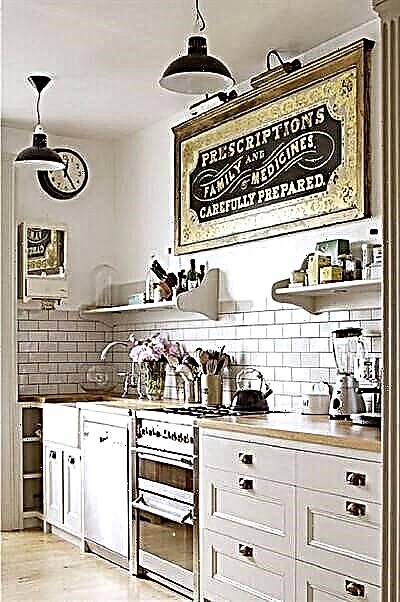 Let's talk a little about what color should be an apron for a kitchen in the Provence style. The main rule: there is the main color of the kitchen and the color of the “extras”: decor elements and / or curtains. The color of the apron should be the same color as the “complements”.
Let's talk a little about what color should be an apron for a kitchen in the Provence style. The main rule: there is the main color of the kitchen and the color of the “extras”: decor elements and / or curtains. The color of the apron should be the same color as the “complements”.
If the interior is dominated not by two, but by three colors, then the color of the cabinets and the table becomes the “main” color, the color of the decor, curtains and apron remains additional, and the color of the walls becomes the third (and the second “main”) color.
If the kitchen itself is made mainly in white, you can choose almost any shade for the apron. It can be lavender, greenish, blue or pink, as well as brown.
If one of the two main colors of the kitchen is brown, you need to judge by its shade.
Lavender with a slope in gray, not a “plastic” bright color, is suitable for more “faded” shades of brown. If brown is bright and light, an interesting choice would be dark lavender (or amethyst) or the color of young grass. Almost all shades of brown will suit blue or turquoise color.
"How to choose a tile on the apron of the kitchen?"
Attention! With pink in Provence style, you need to be very careful. Despite the fact that this is still not the best option for the style, it can be used, but only if the kitchen is dominated by three rather than two colors. Otherwise, it is very easy to turn Provence into something "glamorous."
If the kitchen cabinets are light green or blue, the apron can be made light brown or beige. The walls should be white or light warm shades.
Advice! Well, if one of the colors is quite dark or faded, the kitchen should not shine with brightness. We also recommend that you do not use red (only in small quantities - for example, put a spray rose on the table), orange, yellow, black and bright green, as well as bright shades of pink. These colors absolutely do not fit the Provence style.
Conclusion
So, we told you about aprons in the Provence style, about the basic color combinations in the kitchen and the rules for their selection and what materials are best to use. If you choose furniture and an apron well, you can create a kitchen in which it will be nice to be and cook. The interior in the Provence style is very unobtrusive and is unlikely to bother you even after a few years.
Finally, we want to give you advice that allows you not to get tired of the look of the room: hang simple paintings on the wall and put some decor items (say, a wooden cat is perfect for the Provence style), and change them once every few months or a year. This will “refresh” the kitchen. Good luck!
Patchwork
Patchwork tile is not a new, but a trendy design solution resembling patchwork. Most often a geometric or abstract pattern is applied to the surface of the ceramic. There are options for ornaments, as if broken into pieces. When laying such tiles adhere to the principle of randomness - without fitting the elements to the picture.
This allows you to create the very effect of randomness characteristic of patchwork products. To achieve diversity, tiles can be selected from different collections, as long as they match in thickness.
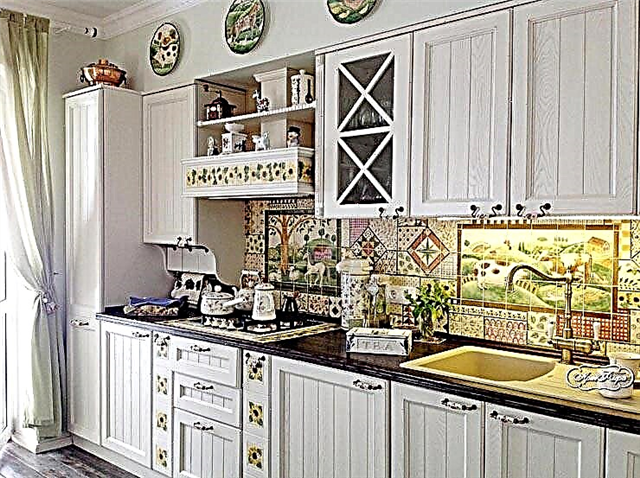
Aged
Tile with scuffs looks messy and creates the effect of neglect of the room, but not in the Provencal kitchen. Manufacturers of modern ceramics produce entire collections of artificially aged tiles for connoisseurs of special decor.
The tile is not only given a specific texture - the manufacturer carefully selects shades so that the effect of antiquity is as natural as possible.
For aged versions of tiles, multitonal coloring is characteristic, and multicolor is observed within the framework of several elements at once.
Rustic style
Rustic tiles are styled with roughly processed materials - wood, solid stone, planks or bamboo. The color schemes of such a tile, respectively, will also be natural and will successfully fit into the Provence style. At the same time, ceramic tiles will fully retain all the useful practical properties - hygiene, fire resistance and ease of care.
Mosaic patterns and panels
The mosaic decoration in the Provencal kitchen will be successfully combined with monophonic tiles, similar in color and similar in size. Now the trend is ceramics imitating a mosaic surface - it is easy to work with it, and the effect is amazing. But the abundance of small details should not look ugly and bulky, flashy shades are not typical for the Provence style.
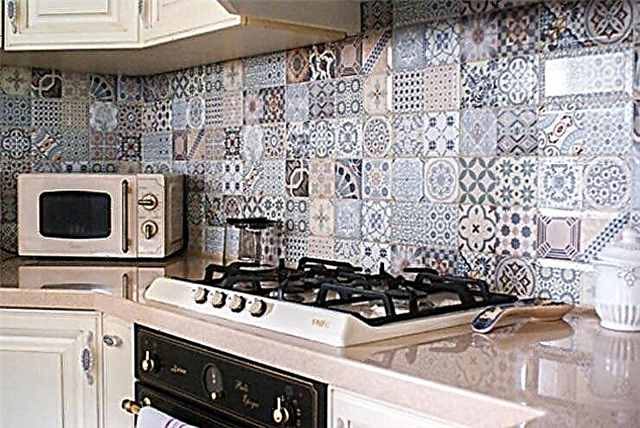
To draw attention to a certain area of the room will help decorative panels. This can be one large module with a complete picture or several small ones assembled into a single composition. For the Provencal interior, it is not necessary to choose images of flowers - ornaments, geometry and even bubble painting are suitable.
A natural stone
Natural stone coating is expensive, but reliable and durable. The apron revetted with a stone decor will serve decades. Moisture and steam, heat and temperature changes are not afraid of him. The stone is appropriate not only in spacious kitchens - in small rooms such a finish looks no less advantageous.
Choosing furniture
The rustic-style kitchen is equipped with natural wood and rattan furniture. Forged products are allowed, preferably with the effect of antiquity. The budget option will be a kitchen set made of MDF with facades imitating natural wood.

Facades must have panels, doors with glass and even metal nets. A good solution is open cabinets and shelves where you can arrange not only decorative elements, but also useful household items. Perfectly fit into the interior and antique items, as well as artificially aged pieces of furniture, massive benches and round dining tables.
It is advisable to give preference to more squat wardrobes and sideboards - tall models will not create the comfort that valued Provence.
Lighting
The Provencal style kitchen should have plenty of light - both during the day and in the evening. Window curtains should be light to allow enough sunlight to pass through. Artificial lighting must be arranged so that the light is soft and diffused. Small spotlights in different parts of the kitchen can be added to the main chandelier.
Wall sconces, table lamps and floor lamps will help to create a warm atmosphere. Their appearance should be concise, decorative elements of wrought metal, textiles, wood, bamboo or straw are allowed. A classic of the genre is a massive chandelier with a fabric lampshade, low hanging directly above the dining table.
Despite the apparent simplicity, the Provencal style kitchen requires careful study of details - from the choice of finishing materials to the purchase of pleasant accessories. Ceramic tiles are assigned one of the leading roles in the design of a "rustic" interior. But thanks to the wide range of modern tiles, difficulties in arranging Provencal cuisine should not arise.


